Key Deer
Odocoileus virginianus
Bucks grow new antlers every year.
Advertisement
Key Deer Scientific Classification
- Kingdom
- Animalia
- Phylum
- Chordata
- Class
- Mammalia
- Order
- Artiodactyla
- Family
- Cervidae
- Genus
- Odocoileus
- Scientific Name
- Odocoileus virginianus
Read our Complete Guide to Classification of Animals.
Key Deer Conservation Status
Key Deer Facts
- Prey
- none
- Name Of Young
- fawn
- Group Behavior
- Solitary
- Fun Fact
- Bucks grow new antlers every year.
- Estimated Population Size
- 700-800
- Biggest Threat
- vehicle collisions
- Most Distinctive Feature
- small size
- Other Name(s)
- toy deer
- Gestation Period
- 7 months
- Litter Size
- 1
- Habitat
- pine rocklands, woodlands, wetlands
- Predators
- Alligator, Crocodile
- Diet
- Herbivore
- Common Name
- key deer
- Number Of Species
- 1
- Location
- Florida Keys
- Group
- herd
Key Deer Physical Characteristics
- Color
- Brown
- White
- Grey-Brown
- Skin Type
- Fur
- Top Speed
- 26 mph
- Lifespan
- 7-9 years
- Weight
- 44-85 pounds
- Height
- 24-32 inches
- Age of Sexual Maturity
- 6 months- 1.5 years
- Age of Weaning
- 12-16 weeks
View all of the Key Deer images!
“Smallest North American white-tailed deer species.”
Key deer, as their name implies, are deer that are native to the Florida Keys. They are the smallest subspecies of white-tailed deer in North America. They look almost identical to their relatives but are more like a miniature version. This is why some people call them “toy deer.” Key deer are closer in size to a dog than some other larger deer species. When alarmed, Key deer lift their tails, showing off the white that lies beneath.
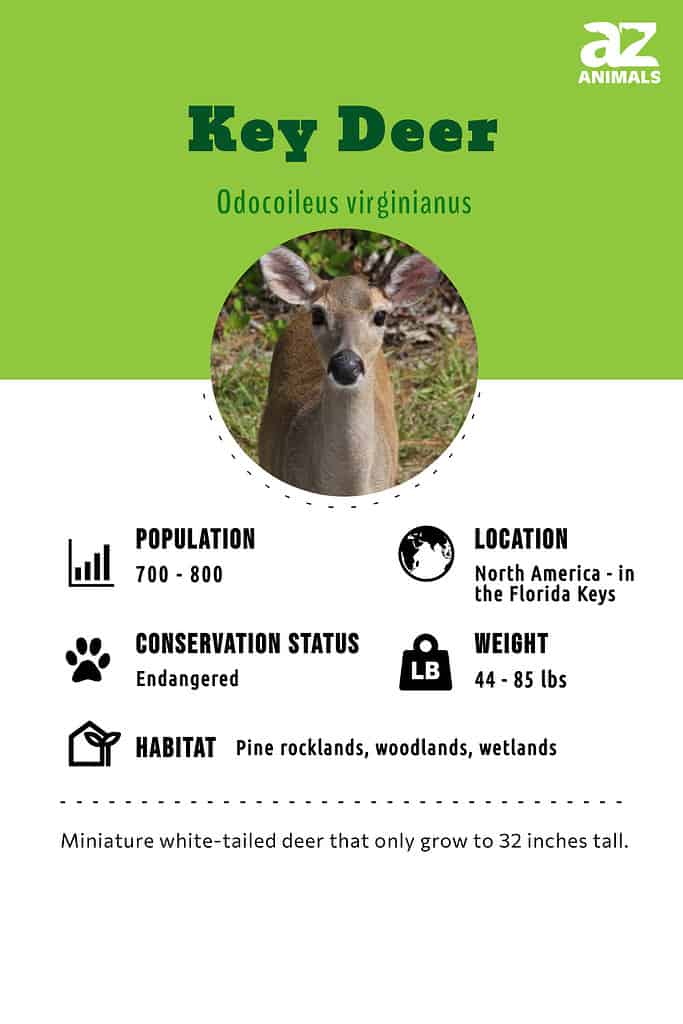
5 Incredible Key Deer Facts!
- Key deer are endangered.
- Key deer are the only existing large herbivore in the Florida Keys.
- Like most deer, Key deer are mostly seen around dusk and dawn.
- By the 1950s, Key deer were almost extinct.
- Key deer have little-to-no fear of humans.
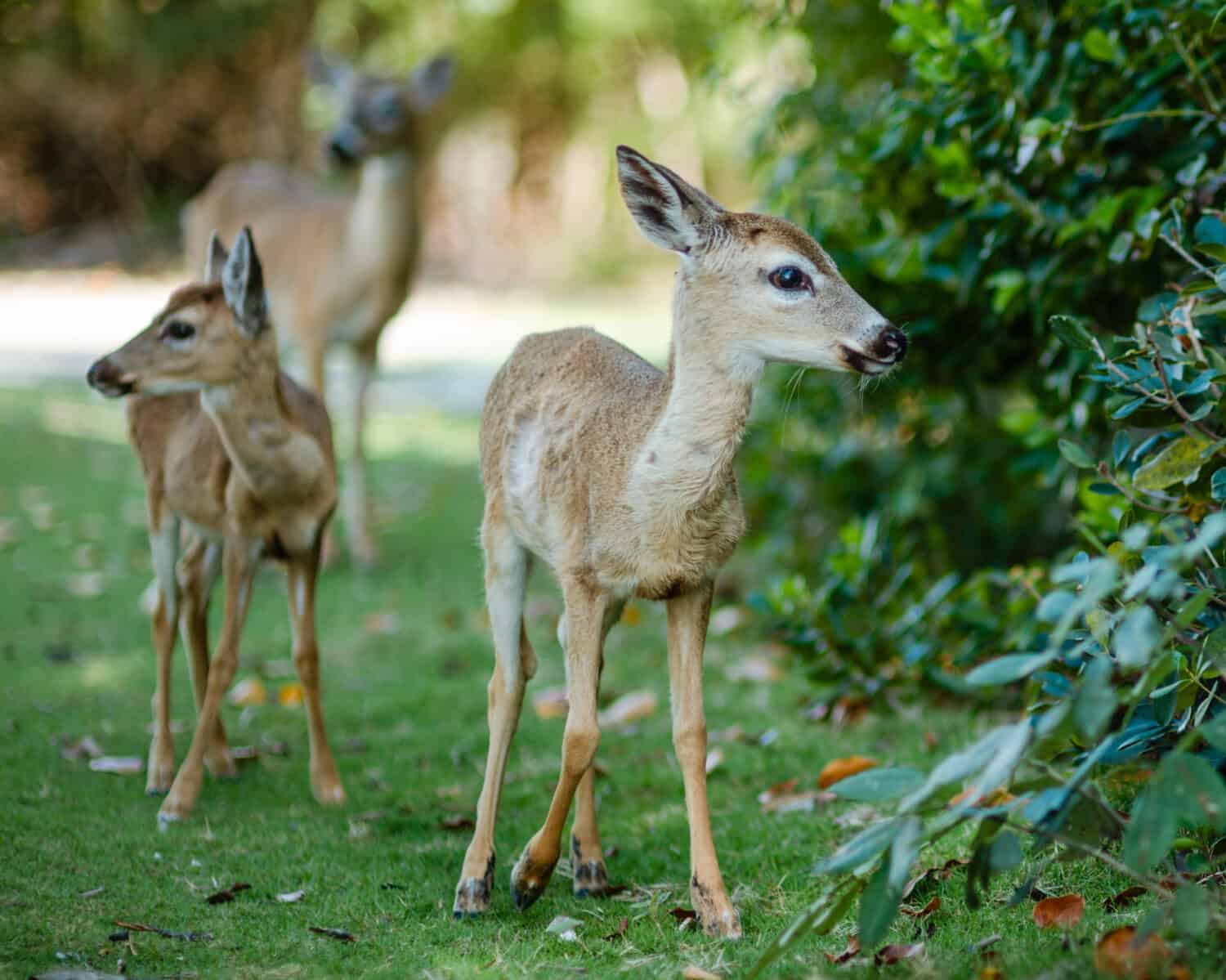
Like most deer, key deer are mostly seen at dusk and dawn.
Image: Abigail Marie, Shutterstock
©Abigail Marie/Shutterstock.com
Scientific Name and Species
The scientific name for Key Deer is Odocoileus virginianus clavium. They are also sometimes called toy deer due to their small size. This species is in the Mammalia class and belong to the Cervidae family. They are a subspecies of white-tail deer, Odocoileus virginianus, which are of the Odocoileus genus.
While there are 38 subspecies of white-tail deer, Key deer do not have any subspecies. The origin of the name Odocoileus virginianus clavium can be broken down into the meaning of each word. Odocoileus stems from the Greek words “odious” (tooth) and “koilos” (hollow) referring to their hollow teeth. Virginianus is a New Latin word that means “of Virginia.” Clavium means “key” in Latin.
Evolution
According to fossil records, the first ungulates appeared around 50 million years ago – during the Eocene. These animals evolved into two groups: those with an even number of toes (Artiodactyls) and those with an uneven number of toes (Perissodactyls). The first real deer didn’t appear until 25 million years later. Many people consider animals like the Syndyoceras to be a precursor to deer – and it shares features with deer, horses, giraffes, and antelopes – and had bony skull outgrowths similar to antlers. These fossils date around 35 million years ago and were found in North America.
Modern deer are believed to have evolved from ancestors during the Oligocene – 30 million years ago. They were small animals with antlers and large tusks that lived in the old world tropics. Deer migrated from what is now Europe across the Bering Land Bridge – and then, in the late Pliocene, approximately 2.5 – 3 million years ago, the Panamanian Land Bridge allowed deer to venture even further south into central and South America.
Appearance & Behavior
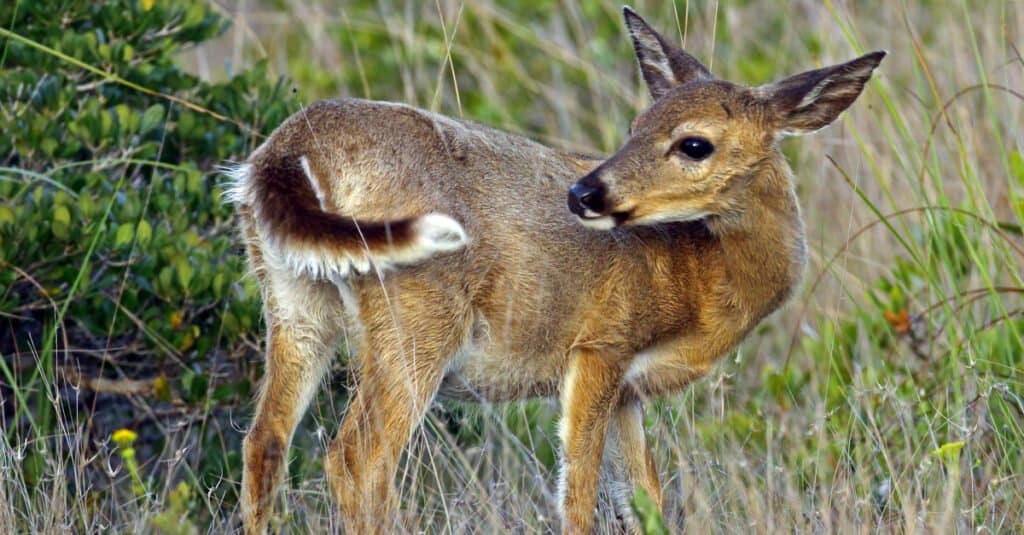
Key deer aren’t afraid of humans and may approach you out of curiosity.
©iStock.com/photographybyJHWilliams
Key deer look similar to other white-tail deer species, but they are smaller. Their fur is reddish-brown to grayish-brown with white on the belly and under the tail. They usually have a darker coloring between the eyes. The snout is black and they have hooves. Males, or bucks, have antlers. They shed these antlers and regrow a new pair each year. Females, or does, do not have antlers.
This animal can be between 24 and 32 inches tall at the shoulders and weigh between 44 and 85 pounds. At the smallest, that is equal to the weight of two dachshunds. On the higher end, the weight is about half as heavy as a kangaroo. The average height for males is 30 inches, about two times the height of a bowling pin. The male’s weight ranges from 55 to 85 pounds. Though it is not typical, the heaviest males can reach up to 100 pounds. For females, the average height is 26 inches, 12 times as tall as a golf tee. Their weight is between 44 and 65 pounds.
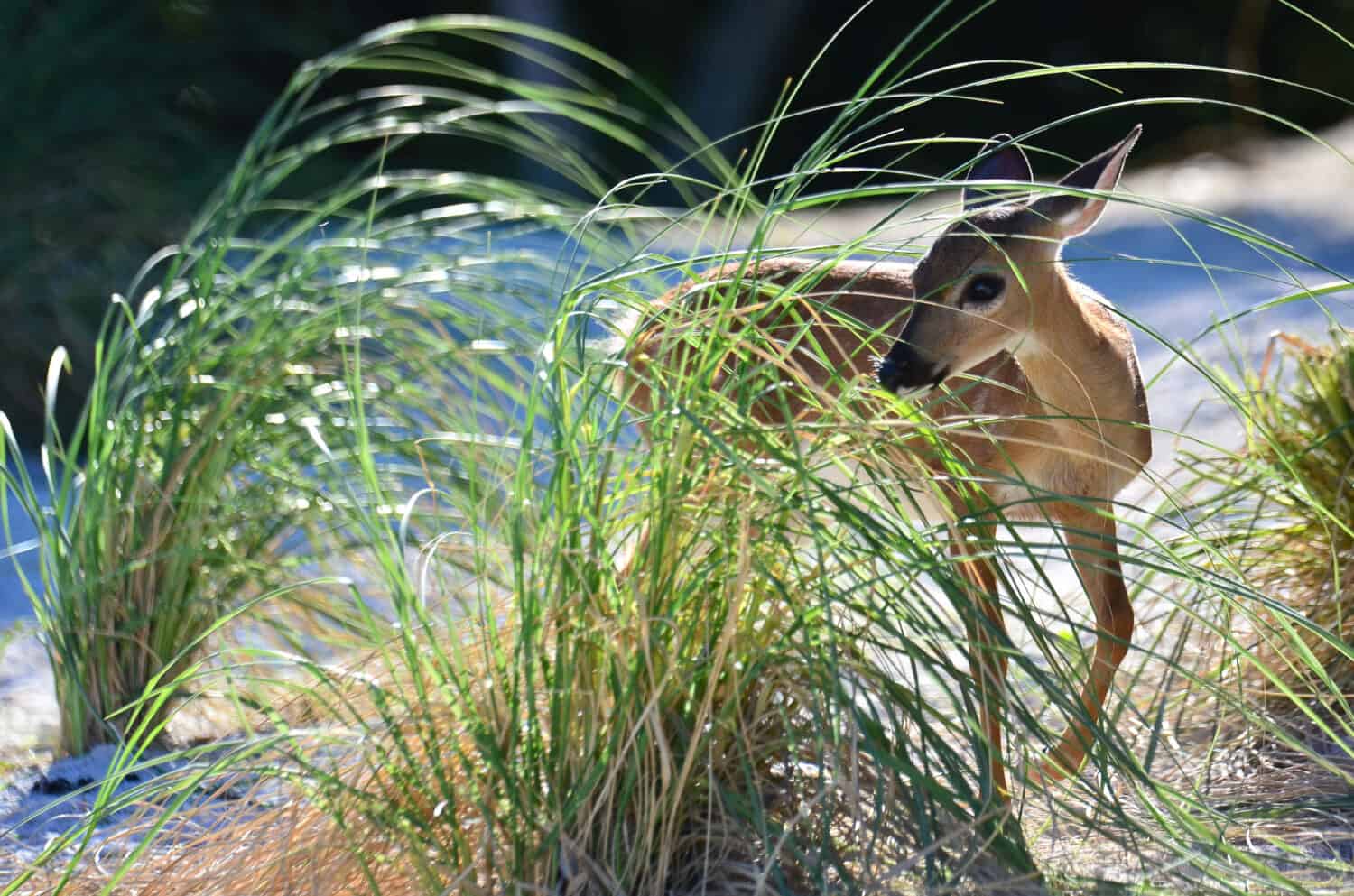
Key Deer are small enough to hide behind a clump of sea oats.
Image: Virginia Blount, Shutterstock
©Virginia Blount/Shutterstock.com
Related species include 37 other white-tailed deer subspecies. Other species have the same coloring as Key deer but are larger. They can reach a height of 3.9 feet. Their legs are longer than a Key deer’s and they have a more narrow skull.
Key deer are mostly solitary. When they do form a group, it is called a herd. They can swim, run, and jump well. They are gentle creatures, however, bucks can become aggressive with each other when they are in a rut. They are not afraid of humans and will approach them for food at times. Key deer are most active during the late evening, night, and early morning.
Habitat

Key Deer are able to swim easily from island to island.
Image: Mihai_Andritoiu, Shutterstock
©Mihai_Andritoiu/Shutterstock.com
Key deer are endemic to Florida, United States in North America. They live primarily in the Florida Keys. Their range used to include all of the lower Keys but after fragmentation, they are only present in Monroe County. They are present from Sugarloaf Key to Bahia Honda Key.
Key deer live in a tropical climate in nearly all habitats. They most commonly inhabit pine rocklands, wetlands, and woodlands. Rocklands provide a source of fresh water for them and are therefore a big part of where they live. In the dryer months, they will travel to places where there is more water available to them. They can swim from one island to another with ease.
Predators & Threats
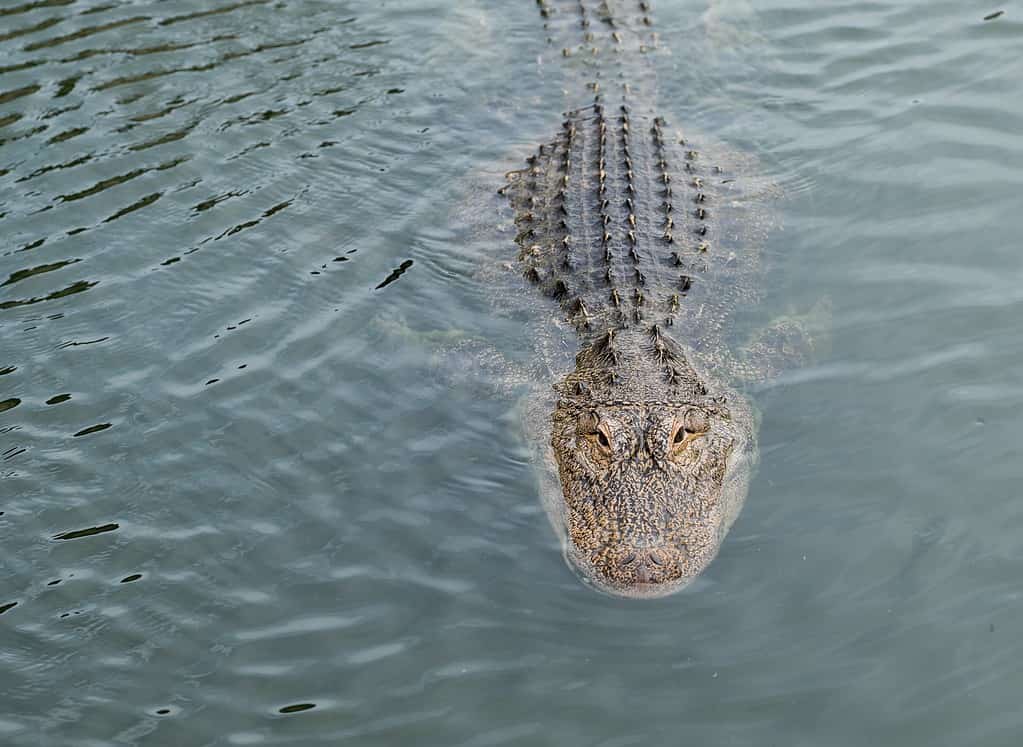
Alligators are a threat to young fawns.
©David Louis Tiffany/Shutterstock.com
Key deer are herbivores. Their diet consists of a large number of plants. Some plants can be toxic to deer, such as rhubarb. Deer can eat between six and eight percent of their body weight in a day. For this animal, that would be three-and-a-half to six pounds of food daily. That is equal to up to 60 times the weight of a golf ball.
Adult Key deer generally do not have any natural predators, other than humans. It is rare for a fully grown Key deer to be killed by wild predators. However, fawns fall victim to large reptiles.
Environmental threats pose a risk to this species as well. Hurricanes can be very dangerous to these animals because they can lead to drowning and further fragmentation and habitat loss. Just as with many other species, humans cause a wide array of problems for these animals. Over-hunting of these animals almost led to their extinction by the 1950s.
After the ban, their numbers recovered partially but they are still affected by other human activity and encroachment. Urban development continues to take over more of their habitat. Illegal feeding by humans and the introduction of non-native plants can disturb their natural diet and impact their nutrition. They are not generally afraid of humans and this makes them more prone to human-related casualties. Sadly, these deer are killed by car collisions fairly often and this is currently considered their biggest threat.
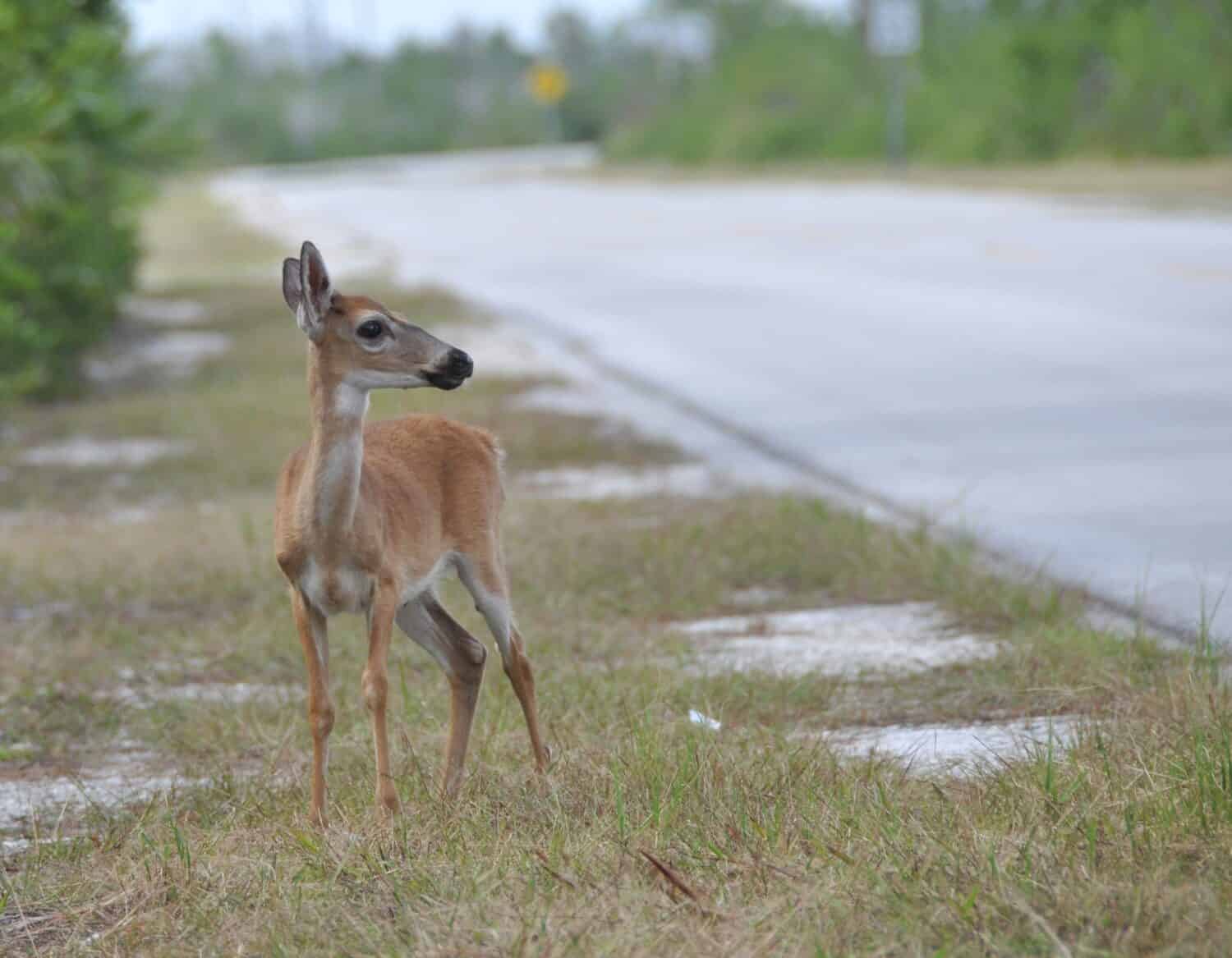
Many Key Deer are killed while trying to cross roads.
Image: Chuck Wagner, Shutterstock
©Chuck Wagner/Shutterstock.com
A parasite known as screwworm greatly affected the Key deer population between 2016 and 2017. This parasite was deadly and killed roughly one-eighth of the herd. The infestation only lasted one year before scientists were able to figure out how to stop it. Since screwworms could only mate once, introducing sterile males was the solution that seemed to successfully eradicate the pests.
“The International Union for the Conservation of Animals” groups Key deer into a broad category of white-tailed deer. They list white-tailed deer as the least concern on the IUCN Red List. However, the federal conservation status of Key deer is endangered. The Florida Natural Areas Inventory classifies them as endangered and critically imperiled.
There have been a few conservation efforts put in place for this species. The National Key Deer Refuge offers a safe haven for these deer. The South Florida Multispecies Recovery Plan was introduced in 1999 and is ongoing. In 2003, part of U.S. Route 1 was lifted to provide a safe place for them to cross underneath the roadway.
National Key Deer Refuge

The National Key Deer Refuge consists of 9,200 acres for the animals to roam freely.
Image: William Silver, Shutterstock
©William Silver/Shutterstock.com
Founded by the US Fish and Wildlife Service in 1957, the National Key Deer Refuge is the main conservation effort in place for Key deer. The refuge consists of 9,200 acres of land for the deer to thrive. The location of the refuge is in Big Pine Key and No Name Key, Florida. About 75% of the population lives in the refuge. To help prevent any more accidents caused by humans, the US Fish and Wildlife Service discourages people from feeding these wild animals. They also ask people to secure their trash and drive slowly when they are in an area where Key deer live.
What eats Key deer?
Known hunters of young Key deer are American alligators (Alligator mississippiensis) and American crocodiles (Crocodylus acutus). They will feed on fawns who are vulnerable or separated from their parents. Before the hunting ban in the late 1930s, humans would eat adults as well.
Diet
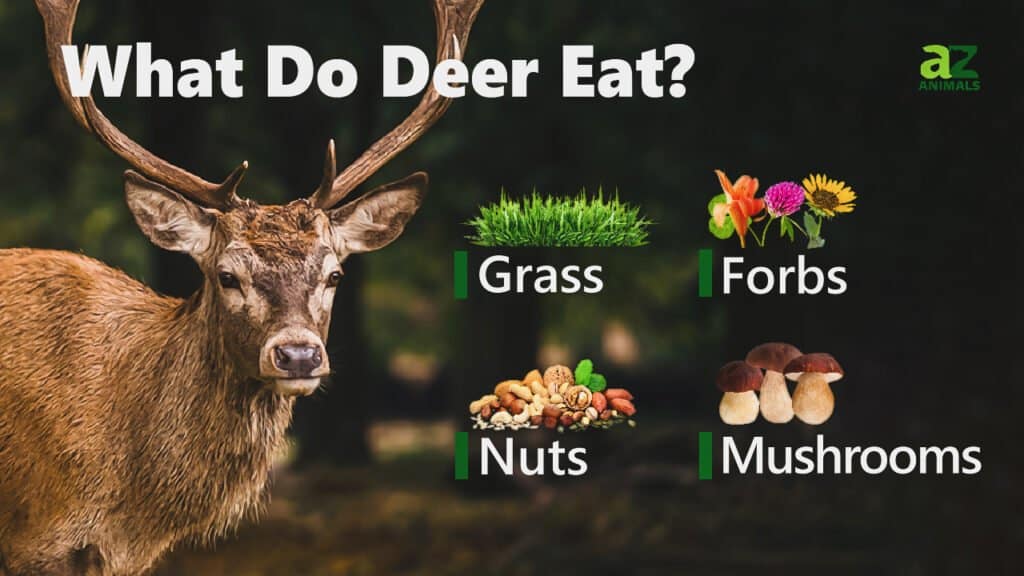
Key deer eat over 150 plant species. Their main food source is leaves and fruit from red, white, and black mangrove trees as well as berries from thatch palm trees. They also eat silver palm berries, acai, grasses, and a variety of flowers. The types of food available will change with the seasons and this will alter their diet slightly.
Reproduction, Babies, and Lifespan
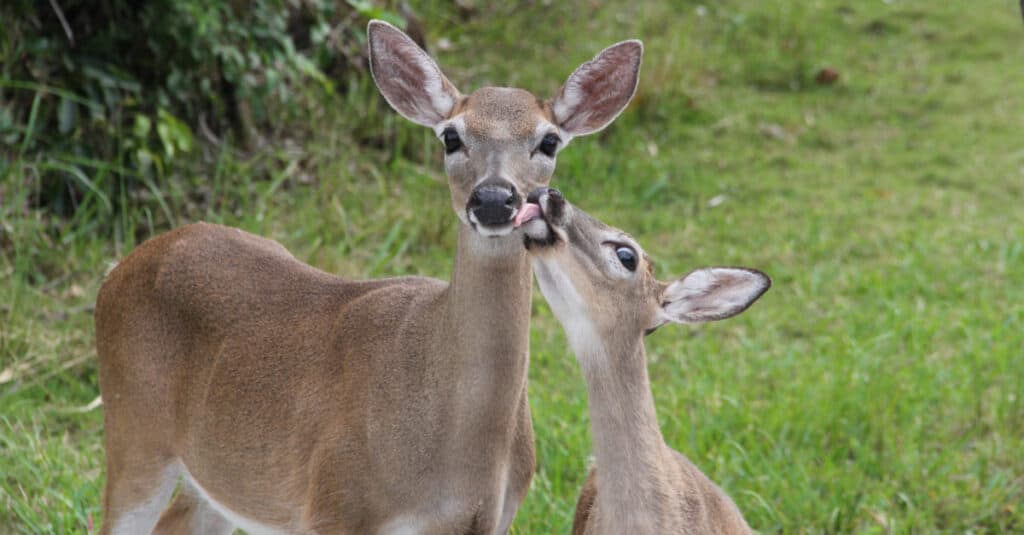
Female Key deer usually give birth to one fawn at a time.
©Arend Trent/Shutterstock.com
When mating season is underway, bucks are in what we refer to as a rut. Fall and winter are the peak rut seasons, though mating can occur year-round. Males will mate with multiple females. To compete for a doe, bucks will fight each other, often locking their antlers. They can become very aggressive with one another and may injure or even kill another buck during the ritual. This is common mating behavior with many deer species. The winning buck earns the right to mate with the doe. Like all mammals, the doe carries the embryo of its young in her uterus. Gestation lasts about seven months before the mother gives live birth.
The mother gives birth to one baby called a fawn. Fawns can walk in under one hour after being born. They are mobile in as little as 30 minutes. They feed on their mother’s milk three to four times a day for about 12 to 16 weeks before weaning. When they are weaned, they eat the same foods as older Key deer. Male fawns typically leave their mother around one year old while females may stay around for years and begin having their own young. Females reach sexual maturity at only six months old. Males mature at 1.5 years of age.
The lifespan of this species is generally seven to nine years. According to the Fish & Wildlife Service, the average lifespan for a male is 2.9 years, and for a female is 6.5 years. The oldest known Key deer was a female who reached 19 years of age.
Population
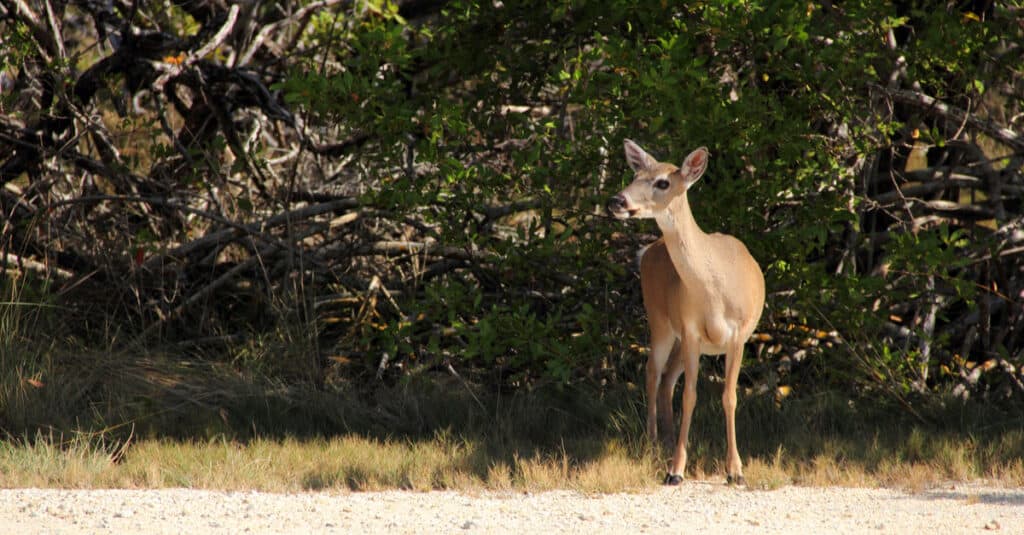
Key deer were declared endangered in 1967 and remain in that status.
©William Silver/Shutterstock.com
Hunting this species was banned in 1939 but there was already too much damage done by poachers over many years. In the 1940s, there were less than 50 Key deer. By 1955, the estimated population was only 25 mature individuals. After some time, the numbers have increased and are currently considered stable. Key deer were declared endangered in 1967 and still are to this day.
Researchers believe that there are less than 1,000 Key deer left in the wild. They are all in the Florida Keys. Today, the population size is estimated to be between 700 and 800 individuals.
View all 77 animals that start with KKey Deer FAQs (Frequently Asked Questions)
How many Key deer are left?
Less than 1,000 Key deer are left in the wild.
How big is a Key deer?
A key deer can weigh between 44-85 pounds and can measure 24-32 inches in height at the shoulder.
Where can I see Key deer?
The National Key deer refuge in Florida is a great place to see these animals.
Why is the Key deer endangered?
The Key deer is endangered due mostly to overhunting and habitat loss.
What do Key deer eat?
Key deer eat a variety of plants including mangroves and thatch palm berries.
What are the primary predators of Key deer?
Primary predators of juvenile Key deer are American Alligators and Crocodiles. Predators of adult Key deer are humans.
Are Key deer carnivores, herbivores, or omnivores?
Key deer are herbivores. They only eat plants.
Can you touch Key deer?
It is highly discouraged to touch, feed, or interact at all with key deer. Human interaction attracts them to dangers such as being hit by cars or attacked by dogs.
Thank you for reading! Have some feedback for us? Contact the AZ Animals editorial team.
Sources
- EOL, Available here: https://eol.org/pages/1240158
- Science Kids, Available here: https://www.sciencekids.co.nz/sciencefacts/animals/deer.html
- Reddit, Available here: https://www.reddit.com/r/todayilearned/comments/581xbv/til_key_deer_is_an_endangered_deer_that_lives/
- Britannica, Available here: https://www.britannica.com/animal/Key-deer
- U.S. Fish & Wildlife Service, Available here: https://www.fws.gov/refuge/National_Key_Deer_Refuge/wildlife_and_habitat/key_deer.html
- The National Wildlife Federation, Available here: https://www.nwf.org/Educational-Resources/Wildlife-Guide/Mammals/Key-Deer
- Nature Serve Explorer, Available here: https://explorer.natureserve.org/Taxon/ELEMENT_GLOBAL.2.101467/Odocoileus_virginianus_clavium
- Florida Fish and Wildlife Conservation Commission, Available here: https://myfwc.com/wildlifehabitats/profiles/mammals/land/key-deer/
- National Deer Association, Available here: https://www.deerassociation.com/fawns-begin-eating-natural-forage/

















